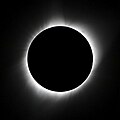| Total eclipse | |
| Gamma | 0.4727 |
|---|---|
| Magnitude | 1.0543 |
| Maximum eclipse | |
| Duration | 245 s (4 min 5 s) |
| Coordinates | 50°06′N83°36′E / 50.1°N 83.6°E |
| Max. width of band | 204 km (127 mi) |
| Times (UTC) | |
| Greatest eclipse | 7:06:27 |
| References | |
| Saros | 124 (45 of 73) |
| Catalog # (SE5000) | 9145 |
A total solar eclipse occurred at the Moon's descending node of orbit on Friday, July 8, 1842, with a magnitude of 1.0543. A solar eclipse occurs when the Moon passes between Earth and the Sun, thereby totally or partly obscuring the image of the Sun for a viewer on Earth. A total solar eclipse occurs when the Moon's apparent diameter is larger than the Sun's, blocking all direct sunlight, turning day into darkness. Totality occurs in a narrow path across Earth's surface, with the partial solar eclipse visible over a surrounding region thousands of kilometres wide. Occurring about 2 days before perigee (on July 10, 1842, at 7:50 UTC), the Moon's apparent diameter was larger. [1]
Contents
- Observations
- Artistic depictions
- Eclipse details
- Eclipse season
- Related eclipses
- Eclipses in 1842
- Metonic
- Tzolkinex
- Half-Saros
- Tritos
- Solar Saros 124
- Inex
- Triad
- Solar eclipses of 1841–1844
- Saros 124
- Metonic series
- Tritos series
- Inex series
- References
The path of totality was visible from parts of modern-day Portugal, Spain, Andorra, France, Monaco, Italy, Austria, Slovenia, Hungary, Slovakia, southeastern Poland, Ukraine, southeastern Belarus, Russia, Kazakhstan, Mongolia, China, the Ryukyu Islands, and the Northern Mariana Islands. A partial solar eclipse was also visible for parts of Europe, North Africa, Asia, Alaska, Greenland, and northern Canada.











































































































